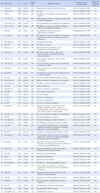Abstract
Purpose
The study was done to verify the effect size of the variables related to the emotional labor of nurses.
Methods
A total of 47 article on variables related to the emotional labor of nurses and published from 2006 to 2014 were used for the meta-analysis.
Results
Variables with the largest effect size related to emotional labor were identified as the variables of work task, organization and individual characteristics in descending order of effect size. The sub-factors with the greatest effect size in the work task variable were exhaustion and work commitment, while for organization variables, intention to change jobs had the largest effect size. For individual characteristics, physical symptoms had the largest effect size.
Figures and Tables
References
1. Kim IS. The role of self-efficacy and social support in the relationship between emotional labor and burn out, turn over intention among hospital nurses. J Korean Acad Nurs Adm. 2009; 15(4):515–526.
2. Yoon SH. The effects of organizational managerial characteristics and job characteristic on job stress and job effectiveness: A survey on clinical nurses. Korean J Ind Organ Psychol. 2004; 17(3):451–466.
3. Hochschild AR. The managed heart: Commercialization of human feeling. Berkeley: University of California Press;1983.
4. Doopedia. Feeling [Internet]. cited 2013 August, 10. https://www.doopedia.co.kr/doopedia/master/master.do?_method=view&MAS_IDX=101013000825237.
5. Morris JA, Feldman DC. The dimensions, antecedents, and consequences of emotional labor. Acad Manage Rev. 1996; 21(4):986–1010. DOI: 10.2307/259161.
6. Brotheridge CM, Lee RT. On the dimensionality of emotional labour: Development and validation of the Emotional Labour Scale. Paper presented at: The First Conference on Emotions and Organizational Life. San Diego, CA: 1988.
7. Mann S, Cowburn J. Emotional labour and stress within mental health nursing. J Psychiatr Ment Health Nurs. 2005; 12(2):154–162. DOI: 10.1111/j.1365-2850.2004.00807.x.
8. Lee SN, Kim GA. Relation of among emotional labor, burn out and job involvement of nurses. Paper presented at: The 40th Anniversary Conference of the Korean Society of Nursing Science. Seoul: 2010. http://www.dbpia.co.kr/Article/3323914.
9. Park MM, Han SJ. Relations of job satisfaction with emotional labor, job stress, and personal resources in home healthcare nurses. J Korean Acad Community Health Nurs. 2013; 24(1):51–61. DOI: 10.12799/jkachn.2013.24.1.51.
10. Song MS. Influence of emotional labor on job involvement, job satisfaction, and turnover intention of clinical nurses. J Korea Acad Ind Coop Soc. 2014; 15(6):3741–3750. DOI: 10.5762/KAIS.2014.15.6.3741.
11. Cha SK, Shin YS, Kim KY, Lee BY, Ahn SY, Jang HS, et al. The degrees of emotional labor and the its related factors among clinical nurses. J Korean Clin Nurs Res. 2009; 15(2):23–35.
12. Kim JJ. Services industry of corresponding emotional labor and regulatory measures. Mon Labor Rev. 2013; 102:42–54.
13. Lee CY. Patients, caregivers, and language in hospitals laborers violence seriously! Kookmin Ilbo. 2010. 05. 03. Sect. 01.
14. European Agency for Safety and Health at Work. European survey of enterprises on new and emerging risks (ESENER) - managing safety and health at work [Internet]. 2010. DOI: 10.2802/30026.
15. Kim IA, Kim JW, Kim HR, Kim HS, Kim HC, Oh SS. A study of health care worker's emotional labor. KOSHA;2013. 11. 29.
16. Borenstein M, Hedges LV, Higgins JPT, Rothstein HR. Introduction to meta-analysis. Chichester: John Wiley & Sons;2009.
17. Park HI, Nam SK, Yang EJ. Relationships of burnout with job attitudes and turnover intention among Koreans: A meta-analysis. Korean J Ind Organ Psychol. 2011; 24(3):457–491.
18. Law M, Stewart D, Pollock N, Letts L, Bosch J, Westmoreland M. Critical review form-Quantitative studies [Internet]. 1998. cited 2011 September 13. http://srs-mcmaster.ca/wp-content/uploads/2015/04/Critical-Review-Form-Quantitative-Studies-English.doc.
19. Duval S, Tweedie R. Trim and fill: A simple funnel-plot-based method of testing and adjusting for publication bias in meta-analysis. Biometrics. 2000; 56(2):455–463. DOI: 10.2307/2676988.
20. Orwin RG. A fail-safe N for effect size in meta-analysis. J Educ Stat. 1983; 8(2):157–159. DOI: 10.2307/1164923.
21. Cohen J. Statistical power analysis for the behavioral sciences. 2nd ed. Hillsdale, N.J.: L. Erlbaum Associates;1988.
22. Zapf D. Emotion work and psychological well-being: A review of the literature and some conceptual considerations. Hum Resour Manage Rev. 2002; 12(2):237–268. DOI: 10.1016/S1053-4822(02)00048-7.
23. Vitello-Cicciu JM. Innovative leadership through emotional intelligence. Nurs Manage. 2003; 10:28–32.
24. Grandey AA. When "The Show Must Go On": Surface acting and deep acting as determinants of emotional exhaustion and peer-rated service delivery. Acad Manage J. 2003; 46(1):86–96. DOI: 10.2307/30040678.
25. Kim IH, Noh S, Muntaner C. Emotional demands and the risks of depression among homecare workers in the USA. Int Arch Occup Environ Health. 2013; 86(6):635–644. DOI: 10.1007/s00420-012-0789-x.
26. Murcia M, Chastang JF, Niedhammer I. Psychosocial work factors, major depressive and generalised anxiety disorders: Results from the French national SIP study. J Affect Disord. 2013; 146(3):319–327. DOI: 10.1016/j.jad.2012.09.014.
27. Lee SJ, Ha EH. The mediating effects of cognitive factor on the relationships between female adolescent's depression and somatization. Korean J Sch Psychol. 2010; 7(1):55–68.
28. Vaccarino AL, Sills TL, Evans KR, Kalali AH. Multiple pain complaints in patients with major depressive disorder. Psychosom Med. 2009; 71(2):159–162. DOI: 10.1097/PSY.0b013e3181906572.
29. Kwon MJ, Kim KS, Ahn SY. Effects of emotional labor, nursing organizational culture on self-efficacy in clinical nurses. J Korea Acad Ind Coop Soc. 2014; 15(4):2225–2234. DOI: 10.5762/KAIS.2014.15.4.2225.
30. Kang M, Kwon MJ, Youn SY. Self-efficacy, nursing organizational culture and emotional labor in clinical nurses. Korean J Occup Health Nurs. 2012; 21(3):266–273. DOI: 10.5807/kjohn.2012.21.3.266.
31. Brotheridge CM, Grandey AA. Emotional labor and burnout: Comparing two perspectives of "People Work". J Vocat Behav. 2002; 60(1):17–39. DOI: 10.1006/jvbe.2001.1815.




 PDF
PDF ePub
ePub Citation
Citation Print
Print







 XML Download
XML Download